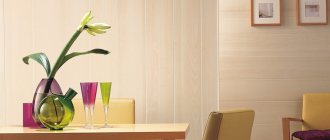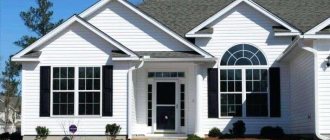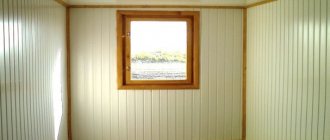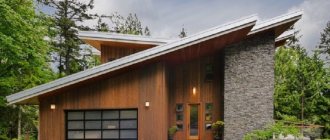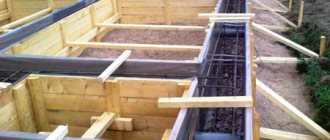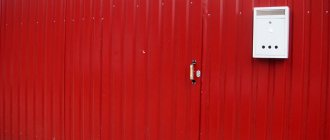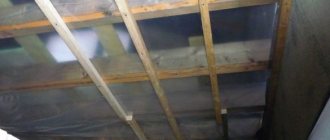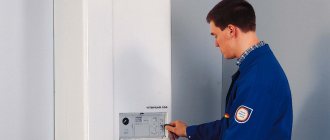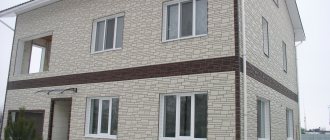Facade panels made of polyvinyl chloride
This is a beautiful, convenient solution - they attach easily, like a construction set, protect the house from moisture and precipitation, protect heat, and create a unique design. There are many of them - made of metal, stone, vinyl, glass. Made of cement and wood, finished to look like brick, like wood, suitable for plastering.
Original color for finishing
But in order for all the benefits to appear, you need to cover the house not with any panels, but with those that are best suited for it. They must be made of suitable material first of all.
Polyvinyl chloride (aka PVC) is the most common material for panels. Its main characteristic is its low price - the mortgage for the cladding of the house may be small.
Beautiful, convenient solution
PVC has advantages:
- Variety . Like any plastic, PVC can be given any color or texture. Patterned panels, panels made to resemble natural wood or stone, brick or glass, multi-colored and with patterns - among PVC there are panels to suit every taste. With their help, you can make any design without thinking about the fact that the wood is rotting, or the stone is too heavy - just choose a good imitation.
- Lightness . PVC is the lightest existing material. This is a big plus, since even the thinnest walls will support its weight and no calculations are required. In addition, you can deliver purchased PVC panels home by your own car, on your own.
- Sustainability . They are not afraid of water, biological irritants, mechanical influences, and retain their original shape well. They cannot be damaged by rodents and parasites, they do not melt in the heat (unless you buy a low-quality segment), and do not require care.
- Easy installation . Due to the weight and ease of fastening, even a person who has never tried to do repairs can handle PVC. And if something doesn’t work out - or if the panel is damaged later - it can always be replaced with another one of the same kind. This will not cause much damage to the budget.
Polyvinyl chloride (aka PVC) is the most common material for panels
PVC is also characterized by durability - some manufacturers promise that their panels will last half a century, or even longer. This, however, is only possible under good weather conditions and the absence of mechanical influences.
The advantages are balanced by the disadvantages:
- Thermal expansion . Installed panels over time, under the influence of heat, can expand and go in waves, completely destroying the entire design. But this behavior is typical for low quality PVC.
- Lack of frost resistance . In the cold, PVC becomes brittle; a slight blow can break or bend it, so installation in the cold is not recommended, and in winter it is better to be careful.
- Lack of fire resistance . In the event of a fire, the panels will not catch fire, but will begin to melt and smoke.
PVC is characterized by durability
Insulating material must be attached under the PVC, otherwise the thermal insulation performance will be low.
There are two subtypes of PVC facade panels:
- Classic . The width is thirty to forty centimeters, the length is from three to four meters. It is most often laid horizontally, since when installing vertically it has to be trimmed, it imitates wood in most cases, although metal is also found.
- Basement . With the same width, it is up to a meter long, which allows it to be laid both vertically and horizontally. It is supposed to be more reliable, but in reality a short bar is easier to replace than a long bar if something happens to it. Most often it imitates natural stone or brick.
PVC is installed from the bottom up, from the foundation to the roof.
In the cold, PVC becomes brittle; a slight blow can break or bend it
Advice In appearance, PVC panels are difficult to distinguish from the material they imitate, especially from afar. Therefore, if you are satisfied with their properties, natural material can be replaced with them.
Types of panels by imitation
The popularity of cladding material is growing at incredible speed, and façade panels are being valued. The main advantage is ease of installation. A wide selection allows you to individually choose any shade and structure. Designers can easily bring any ideas to life. Often specialists use copying natural or artificial materials.
Under the stone
Stone-like façade slabs are often used in exterior decoration. After all, any building covered with this type looks well-groomed and rich. A large palette of colors allows you to choose shades from light to dark stone.
Under the brick
In the construction market, the most popular is a brick-look façade panel. It is used for finishing buildings, fireplaces, walls, and also as a decorative element of partitions.
This building material is made from different raw materials:
- fiber cement;
- polyurethane foam;
- metal with insulation;
- vinyl;
- polymer sand.
The panels replicate smooth or embossed brickwork. Shades close to natural with different execution of masonry joints. They can have the effect of old, burnt or new brick.
Under tiles
Copy tiles are a two-layer material created on the basis of polyurethane and clinker tiles. The difference from polyurethane sheets is the presence of tiles built into the structure. Manufacturing is carried out using high modern technologies. Positive sides:
- Getting rid of mold and dampness. Bacteria cannot survive on the material. The raw materials have excellent moisture-resistant properties.
- Can be used for homes with both pillar and strip foundations.
- Clinker production is based on fired clay.
- Installation is done on special profiles without connections. The covering under the tiles is sealed. Sheets of material do not add much weight to the structure.
Under the tree
Wood-look slabs - copying a round log. Ideal for finishing saunas and baths. But for realism, you need to do this inside and outside the room.
Made of wood
Wooden facade panels are made either from lining or plank. Despite the fact that both are boards, they have specific features that affect the design and the nuances of operation.
Option for decorating a house with wood
Lining is a thin board with a convex surface. It has grooves on both sides with which one strip is attached to the other. It is usually made from inexpensive types of wood, most often coniferous.
The advantages are as follows:
- Easy to install . It is no more difficult to assemble than PVC - the same “insert a tenon into the groove, latches, repeat” construction kit.
- Natural material . This is more a matter of aesthetics than anything else - the lining looks like natural wood. The pattern of the bark is always different, as is the shade of color.
- Environmental friendliness . The material is breathable and does not emit any harmful fumes.
- Low price . Lining costs only a little more than PVC.
Wooden facade panels are made either from lining or planken
But like most natural wood, lining is not stable. It rots and swells from moisture. Dry heat causes it to dry out and crack. It can be damaged by parasites, and moss can grow on it . To avoid this, you need to update the special composition covering the façade from time to time (preferably every spring).
There are no such problems with planken. It is the same board, but with a smooth surface and without any grooves. Its edges are either straight or beveled, and the thickness is usually around two centimeters. They are most often made from larch - a relatively expensive tree, but resistant to moisture.
The advantages are as follows:
- Sustainability . Unlike lining, it does not dry out in the heat and does not suffer from humidity.
- Interesting fastening system . Not only does it provide ventilation, but it also allows you to add a finishing touch to the overall design.
- Beauty . Like any natural wood, planken is beautiful.
- Easy to replace elements . Although the installation itself requires more skill than in the case of lining, it is easier to replace a damaged element - you just need to unscrew it, rather than remove it from the groove system.
Wood is one of the most beautiful and expensive materials
Its main disadvantage is its high price. For larch, which is also impregnated with special compounds at the production stage, you need to pay more than for pine.
Interestingly, in the absence of groove fastening, the planken can be fastened in two ways:
- Visible . In this case, the board scrolls through, straight to the facade. Self-tapping screw caps can be a small but interesting touch to the design.
- Hidden . In this case, the board is attached to a special device attached to the facade - from the outside it seems that nothing is holding it.
Installation of this material requires great skill
Both lining and plank are flammable - if there is a fire in the house, the facade will also burn.
Advice Wood is a beautiful material, but rather impractical (or expensive). It makes sense to install it only if you want wooden panels and no others.
Wood siding for exterior home decoration
Wooden siding. (photo No. 2)
Siding as a practical finishing material was first used in America. It was made of wood back then. The panels were mounted at an angle to the facade so that water would flow to the ground without getting on the walls. This installation method was called “herringbone”. Nowadays, wood siding is used less and less, despite the fact that it is the most environmentally friendly option. But he is demanding in care:
- It is important that installation takes place under appropriate conditions. It is not recommended to do this in frost and high humidity - otherwise the wood may subsequently become deformed.
- You need to prepare the material correctly. If the moisture level of the wood is higher than normal, the panels may crack or become covered with dark spots when drying.
- Wood must be treated to protect it from moisture, mold and pests. The first time is during installation, and then every 2-3 years.
- Wood burns easily. Therefore, the facade must be treated with special compounds for fire safety.
!
Wooden siding must be treated with protective agents: against moisture, pests and for fire safety.
Wood siding also has advantages:
- provides good thermal insulation,
- quiet: the rain will not drum on the facade, causing headaches for household members.
- looks beautiful - as a rule, it retains the natural color and texture of wood.
Made of metal
Metal is a relatively expensive material, the price of which directly determines the quality of the resulting facade. Has the following advantages:
- Lightness . Of course, the metal weighs more than PVC, but it is still light enough to be easily delivered.
- Durability . Unlike PVC and lining, metal will not be damaged by mechanical influences - it is difficult to break it or make a hole. It might just leave a small dent, but it can be straightened out.
- Sustainability . The metal is resistant to fire, biological irritants, and temperature changes. It does not change from the heat, does not become brittle in the cold. Pests cannot harm it.
- Moisture resistance . It is provided either by stainless steel or by a special coating. The second is cheaper, but also more fragile - if the coating is damaged, the metal underneath will quickly rust.
- Aesthetics . Metal comes in different colors, but it is always beautiful, has a specific shine, and a special charm. Available in different colors, it can even have a mirror surface.
Metal is a relatively expensive material
Of course, it has disadvantages:
- Noise . If you install the panels horizontally, at a slight angle, every time it rains, the drops will drum on them, creating a loud, annoying sound.
- Difficulty in installation . The metal is most often welded into a single sheet - this way it becomes insensitive to any influences at all, but the procedure requires equipment and skills that you most likely do not have. In addition, after completion of the work, it will be difficult to replace one failed panel. And even if the panels are installed with screws, holes will need to be drilled for them, which also requires skill.
It is imperative to lay a layer of thermal insulation under the metal . If wood can do without it, then metal cannot. It also accumulates static electricity, so attaching satellite dishes and air conditioners to such a façade is a bad idea.
Has a specific shine and special charm
Advice: Metal should be used to cover the facade if it goes well with the architecture of the house. The effect of its use is usually very severe.
What type of facade panels is most optimal?
When choosing curtain wall cladding, you should be guided by the practicality of the material, its durability and the feasibility of installation on a specific building.
The facade of the house needs protection, which, among other things, should be aimed at aesthetic satisfaction. The taste of the home owner is of great importance when choosing.
Don’t forget about quality: it’s better to choose material from trusted manufacturers and their official dealers. In addition, it is important to consider the material of the house itself: its compatibility with the cladding.
Thus, facade systems, when installed correctly, will contribute to the protection of the building and its decorative design.
Made from fiber cement
Fiber cement differs from ordinary cement mainly in the processing method: it is first mixed, then passed through special holes under high pressure, forming the panels directly. Then they let it sit for several hours, bake it at high temperature and cover it with compounds to repel moisture, coupled with general strengthening.
The resulting panels can look like any material and have the following advantages:
- Sustainability . They do not burn, do not rot, are not afraid of biological threats, do not suffer from heat or cold, and do not change color in the sun.
- Lightness . Heavier than PVC, they can be compared to wood in lightness.
- Durability . Resistant to mechanical damage and can last up to half a century.
- Thermal insulation . Unlike PVC and metal, it does not require additional insulation - the material itself retains heat quite well.
- Variety . Fiber cement is produced painted in different colors, forged to resemble different materials. Its surface can be smooth or textured, so similar to wood or stone that it is difficult to distinguish.
- Possibility to carry out installation in any conditions . Even in extreme cold.
Fiber cement differs from ordinary cement in the way it is processed
Fiber cement is so resistant to moisture that this can become a problem - not only will it not penetrate inside, but it will also not get out, which can affect the strength of the facade walls. In addition, over time, the slabs deform, although only by two percent - this is not very noticeable.
The peculiarity of fiber cement is that you can not only buy it ready-made, but also paint it yourself.
Advice If you want to finish the facade without particularly increasing the load on the foundation, and then also paint it to your taste, fiber cement is a good solution. Especially if you don’t want a uniform color, but an intricate pattern and hand painting.
This material is resistant to moisture
Facade cassettes
Facade cassettes are a relatively new material. In a short time of existence, this type has gained wide popularity, especially when finishing large buildings.
Facade cassettes allow you to combine colors, panel sizes and create a variety of rectangular profiles.
The material for them is a metal profile made of either aluminum or steel. Thanks to this, a second name was born - metal cassettes. The structure consists of the following elements:
- metal profile;
- wind panels;
- fasteners, mounting parts.
Metal cassettes are attached directly to the base with a gap that can be filled with hydro or thermal insulation.
Advantages of aluminum facade cassettes:
- durability and strength;
- minimum installation time;
- protection of the facade from exposure to wind, solar radiation, moisture;
- resistance to open flame;
- wide temperature range;
- minimal load on the foundation due to its low mass.
Steel analogues have the same advantages, but they are significantly heavier. Before using steel cassettes, you must make sure that the additional load caused by the increase in the weight of the building will not lead to negative consequences.
From glass and stone
Both glass and stone are used quite rarely for facade decoration. This is due to a number of specific disadvantages:
- Great cost . The stone must be mined and delivered, the glass must be made and tempered so that it is resistant to mechanical damage.
- Weight . Both materials weigh so much that transporting them becomes a problem. In addition, you also need to calculate the load on the foundation - if it is too large, the house will simply sag.
- High thermal conductivity . Both materials heat up easily and cool down just as easily. In summer they provide an additional increase in temperature inside the house, in winter - a decrease. And while stone can still be insulated, glass can’t always be.
- Difficulty in installation . The glass is attached to a special metal mesh, which you still need to be able to install - and a person without experience cannot do this. The stone is mounted on panels, which are difficult to attach due to the resulting heaviness.
The house inside will always be full of light
In addition, if the stone does not require any maintenance, then the glass must be washed regularly with special products, otherwise it will lose its transparency, and with it its main advantage - its chic appearance.
The disadvantages of both materials are the same. But each has specific advantages.
For stone it is:
- Reliability . Any structure made of stone can last for centuries, since it is not sensitive to mechanical damage, does not wear out, does not fade in the sun, does not suffer from temperature changes, does not become brittle in the cold, and does not warp from heat. He is not afraid of biological threats, he can withstand any weather. The maximum that can happen to a stone façade is that moss will grow on it, but this will only benefit some designs.
- Aesthetics . Natural stone is beautiful, like any other natural material. Each stone in the masonry is unique.
The stone does not require any maintenance
Of course, a stone cannot be given a color other than its natural one, but this is a very conditional minus - after all, a stone is bought so that it pleases with its natural beauty.
Glass has other advantages:
- Beauty . Regardless of whether the glass panels are used as walls or fixed to them, the result will look amazing in any case. Plus, in the first case, the inside of the house will always be full of light.
- Variety . There are different glasses - frosted, transparent, mirrored, coated, engraved, changing color in the sun, reinforced. With their help you can create a magnificent composition, especially if you combine several types of glass.
Natural stone is beautiful, like any other natural material.
Suitable for façade finishing:
- Clear glass . It is used rather to replace conventional solid walls - with their help, part of the facade becomes completely permeable to light. In Russia, unfortunately, this is mostly not applicable - the long, snowy winter is not conducive to making a glass façade for the house.
- Frosted glass . Much more logical in the climate of our country. It is attached to the wall of the house, like ordinary panels, and can have any shade to suit the customer’s taste. To add beauty to it, you can use stained glass inserts (or turn part of the facade into stained glass completely), laser engraving with a pattern, or spraying, which will give the glass a special rough texture. You can even buy reinforced glass, which has a “square” texture.
Part of the facade can even be made mirrored, but on sunny days it will shine and blind everyone who carelessly looks at it.
Advice A completely stone or glass facade is expensive and not always justified. If you are confused by the price, but like the material, you can include glass or stone inserts into the overall design.
Why is it beneficial to cladding a house with facade panels?
The advantages of exterior finishing of a building with facade panels are due to the following factors:
- High strength characteristics;
- Weather resistant;
- Ability to withstand amplitude temperature fluctuations without loss of performance properties;
- High antiseptic properties;
- Fire safety;
- Long period of operation;
- No additional load on load-bearing walls;
- Easy to install, allowing you to install it yourself;
- A wide range of simulated natural materials;
- Minimum maintenance requirements;
- Affordable price.
All these indicators eloquently indicate the feasibility of using facade panels for the exterior decoration of a house or any other building.
Sandwich panels
Sandwich panels are, in fact, ready-made facade cladding that does not need additional insulation; it is enough to simply attach it to the wall. It consists of two layers of facing material, between which insulation is poured.
Gothic style house
For outer layers usually use:
- Metal . The material is thin, durable, and desperately needs additional insulation, since it cannot provide thermal insulation itself. Resistant to everything, durable, beautiful, but installing panels from it is difficult.
- PVC . It becomes fragile in the cold, can emit toxic fumes if the quality is poor, but it costs little, comes in a variety of colors, is easy to transport, and easy to secure.
Sandwich panels are, in fact, ready-made facade cladding
Neither wood, nor fiber cement, nor glass, nor stone are used for sandwich panels, since they themselves are capable of providing thermal insulation.
The following insulation is used for the inner layer:
- Mineral wool . It does not burn, does not rot, is not sensitive to biological threats - no parasites will grow in it. But you need to pay attention to tightness - if moisture gets on the cotton wool, it will lose most of its thermal insulation properties.
- Polystrol . It does not deteriorate due to water and lasts a long time, but it burns, emitting acrid black smoke, and also suffers from biological threats - rodents can live in it. It is also not resistant to sunlight and, if there is a hole in the panel, it will partially collapse.
- Polyurethane foam . More expensive than other materials, but also better in terms of heat retention - it releases it two times slower than mineral wool, and one and a half times slower than polystyrene. Does not burn, does not suffer from moisture, very light. The only drawback is that it can harbor rodents.
This material is easy to assemble
You can combine materials in three ways:
- Assemble on site . In this case, you buy sheets of facing material, insulation and glue, and then you can assemble them into sandwich panels right on site. The advantages are ease of delivery, since everything is easier individually. The disadvantage is low quality, especially if you violate the assembly rules.
- Pour . In this case, you buy facing sheets and a container of polyurethane foam, and then fill the voids between the sheets. The disadvantage is that you have to wait until everything dries, and in addition, if you act carelessly due to inexperience, gaps may form in the thickness of the foam, worsening the thermal insulation.
- Buy now . Conveyor assembly is more expensive and requires careful delivery. But at the same time, sandwich panels are precisely made in accordance with all GOST requirements and will last for decades. And if something turns out to be wrong with them, you can always contact the seller with a complaint.
Beautiful house in modern style
Regardless of how the materials were combined, sandwich panels have advantages:
- Easy to install . Sandwich panels are assembled according to the same design principle, where you need to fix the tenon into the groove and you can move on to the next coupling.
- Sustainability . Any external material will easily survive humidity, temperature changes, and any atmospheric phenomena.
- No need to insulate . Cladding the façade with sandwich panels means simultaneously insulating it and covering it with cladding material.
- Lightness . The panels do not place any special load on the foundation.
Rustic style
There are also disadvantages:
- Lack of aesthetics . Only the simplest architectural structures can be covered with sandwich panels, since they do not bend, cannot be cut, and the length cannot be adjusted.
- Flammability . Almost all fillers are flammable, which will affect them in the event of a fire.
Simple and inexpensive home decoration
The design of sandwich panels is usually the simplest: a uniform bright color. You can make a house striped, but you won’t be able to create complex patterns with them.
Advice If you want to clad your façade with plastic or metal, choose sandwich panels. The aesthetic effect will be exactly the same, but you won’t have to bother with insulation.
This will be interesting for you:
210+ Photos of Beautiful brick houses (one-story/two-story). Do-it-yourself façade cladding
Facade materials for exterior finishing of a house (225+ Photos): types of cladding with incredible results
Advantages and disadvantages of panels
Facade panels for finishing private houses have a lot of advantages:
- Strength.
- Resistant to water.
- Wide temperature range.
- Immunity to the appearance of microorganisms, mold, mildew, etc.
- Non-flammable and fireproof.
- Ability to correct defects in wall surfaces.
- Long service life.
- Light weight, do not create a load on the base or walls.
- Easy to install, the ability to cover the house with your own hands.
- High decorative possibilities, a large number of options to choose from.
- Virtually no maintenance required.
- Relatively low cost.
However, there are disadvantages:
- High coefficient of thermal expansion.
- The need to fulfill special requirements during installation that the installer must be aware of.
- If you need to replace one panel, you will have to disassemble the entire panel.
These shortcomings are not decisive, but they must be taken into account.
IMPORTANT!
Both the advantages and disadvantages of facade panels are not absolutely common to all representatives of the group. Some types do not have these properties, which is explained by the characteristics of the material.
Design nuances
A weather- and mechanically resistant material that provides thermal insulation and protects the walls of the house from wear and tear is not all that is usually needed to enjoy looking at the house. Otherwise, everyone would live in houses covered with simple sandwich panels. Aesthetics are important.
Brick finish
It is affected by the location of the panels:
- Vertical . It will make the house visually taller, which is useful for small, squat houses.
- Horizontal . Will make the house appear lower and wider, which is useful for tall houses that look too narrow.
- Brick . It is used for base planks - they are not laid exactly on top of each other, but with an indentation, just like bricks are laid. It looks good and does not bring any special visual changes to the shape.
Vertical products will make the house visually taller
It is influenced by colors:
- Bright white looks good, but it needs to be washed constantly, otherwise it will fade and turn gray very quickly.
- Bright black is not usually used for houses unless it is a Gothic style home. The exception is a black background with a bright pattern or accessories that attract attention. But still, it is generally considered that the effect is too dark.
- Shades of yellow. The sunny color will attract attention to the house, making it visually cozier and more pleasant. A common color that looks good in a garden setting.
- Shades of green. They are rarely used for summer cottages, since a green house surrounded by greenery will look a little strange. But for a country cottage surrounded by other buildings, a garage and a neat garden, soft shades of mint or light green are well suited.
Bright white looks good but needs constant washing
- Shades of red. They are usually considered too bright and therefore undesirable, but muted options, such as brick, fully correspond to the classic ideas of a country house.
- Shades of brown. They look good and remind you of village houses. But it is not recommended to take cold or too dark ones.
- Delicate shades. Beige, pink, peach. They will make the house a little larger and more comfortable in appearance. Well suited for small houses where coziness is the main idea of the design.
- Cool shades. They will also make the house look larger, but at the same time more austere and darker. Pairs well with glass or metal inserts.
This is affected by the finish:
- Clean plastic . It does not look very aesthetically pleasing, because at one glance it seems that the house was cheap for the owners. But for a small house, which should not be too sophisticated, it is adequate.
- Pure wood or stone . Natural materials are always beautiful. The tree looks warm, cozy, reminiscent of villages and pleasant childhood memories. Stone is more austere, but if combined with wood, it will look softer.
- Pure metal . It goes well with glass, perfect for decorating a home in a high-tech style. Gives a special shine and severity of style. Reminds me of skyscrapers and industrial buildings.
- Clean glass . It goes well with metal, it really depends on the specific glass. Transparent looks extravagant, rich, a little strange. Matte is reminiscent of the sea, tall buildings, and the centers of large cities. It is good for frosted glass to be colored, this gives it additional charm.
Stylish country house
- Under the brick . It is made using PVC panels, the plastic for which is poured in several layers into a mold that replicates natural brickwork. From a distance it looks indistinguishable from real brick, is well suited for a house in a classic style, plus it allows you to save money - PVC is cheaper than real brick and much lighter.
- Under the tree . Made using fiber cement or PVC, it allows you to enjoy the aesthetic appearance, forgetting about all the shortcomings of wood and the fact that it needs to be renewed so that it does not rot. From a distance, again, it is indistinguishable, but up close it reveals nuances of color. The uniqueness of natural wood is missing.
- Under a stone . Natural stone is heavy and expensive, it is better to buy fiber cement or PVC for it. They, of course, wear out faster, but if you want to change the exterior of the house, replacing them will be much easier.
Horizontal products will make the house lower and wider in appearance
Tip It's a good idea to combine different materials. Lay stone-like panels in two rows, and finish the top with wood or wood-like panels. Include glass inserts between metal panels. The main thing is that the result is combined.
Cozy house in Provence style
Before you go to the store for specific panels, you should draw what the house will look like after covering and only if you like everything, start implementing it.
In the store, you need to check whether the panels are chipped or cracked, whether their length and width match each other, and whether the seal of the packaging is broken.
Panels can be attached to any wall, unlike plaster
PVC panels (polymer)
Such panels, as the name suggests, are made from high-quality polyvinyl chloride. The material is resistant to sudden temperature changes, retains its original appearance for a long time, and can imitate almost any natural material. In addition, there is nothing complicated in installing PVC panels.
Note! Such panels can be either basement or façade.
PVC panel for facade
PVC panels are very popular due to their low cost. They are fastened with self-tapping screws and connected to each other with special edge locks. The result is almost invisible joints between the elements.
Facade panels “Stone”
There are also panels with micromarble - this is a more temperature-resistant and more durable material, containing fiberglass and concrete. Such panels weigh little and are not afraid of low temperatures, moisture, or mechanical stress. Install as easily as regular plastic panels.
Comparison of different panels
There are both pros and cons of each type of facade panels. Everyone has strengths and weaknesses.
| Panel type | pros | Minuses |
Metal siding | 1. Take different shapes. 2. Easy to install. 3. Durability. 4. Average price. 5. Stylization. 6. The most durable. | 1. For a house there is no more than one floor, which is due to weight. 2. Metal bends easily. Replacing one component will require reworking the entire installed structure. |
Clinker thermal panels | 1. Lightweight material. 2. Equipped with insulation. 3. Easy to install. 4. Installation speed. 5. Various decor options. | 1. High cost. 2. Subject to mechanical damage. |
PVC | 1. The cheapest of all. 2. Various panel colors. 3. Lightweight material. | 1. Subject to mechanical damage. 2. Not the best option for decoration. |
Wood siding | 1. Durable and beautiful material. 2. Excellent heat-saving qualities. | 1. The most expensive option for facade panels. 2. For a one-story house. |
Siding under plaster | 1. Reasonable price. 2. Excellent heat-saving qualities. | 1. Subject to mechanical damage. |
The fundamental differences will be in the price and durability of the products. Of course, each of the above options has its own individual characteristics, which is why such panels are chosen.
Aspects of choosing façade panels
It is worth noting that the panels are created not only to improve the appearance of the building, but also to hide various types of insulation. Moreover, the panels allow you to hide not one, but even two or three layers of insulation. It all depends on the type of product, the height of the frame and the correct installation.
In addition, panels can and should be used to insulate not only residential premises. Such a move as insulation and the use of panels for the facade of a building is used in industrial enterprises. For large rooms this is a huge plus for saving heat inside the building. For industry, PVC panels are most in demand due to the price-quality ratio.
The difference between facade panels, bricks and stones
The first thing you should pay attention to is the price. Facade panels are made of high-quality and inexpensive polymer. The production of such panels is much cheaper than the production of facade bricks and decorative stones.
FineBer facade panels
Docke-R facade panels
Color of facade panels
The installation method differs. If a few fasteners and screws are enough for panels, then much more is needed for brick and stone. Stone and brick take much longer to lay, due to the nature of their installation - cement, sand, and water are required. In addition, the stones must be adjusted to each other. The panels are installed on a pre-installed frame. Various mineral wool and foam insulation can be installed underneath them.
Fiber cement panels for plaster
Such products have a number of advantages over others:
- the weight of such products is insignificant, there is no load on the walls and frame;
- high thermal insulation. In addition, you can additionally install insulation between the frame and the panel;
- good condensate drainage. The walls of such a facade seem to “breathe”.
However, such panels are not without drawbacks. The most important of them is fragility. Products are subject to mechanical damage. At the same time, replacing one panel entails recycling the entire frame.
Siding under plaster
Characteristics of fiber cement panels
Panel options
Another advantage is the installation method. Such panels are installed in the same way as the above metal siding panels.
Installation diagram of fiber cement panels on a flat surface
Installation of fiber cement siding, diagram
Step by step, the entire installation looks like this:
- The installation site is being prepared. The facade must be cleaned and interfering decor must be dismantled;
- an installation diagram is created. The diagram is necessary for further planning of material purchases in order to accurately calculate the number of panels themselves, additional elements and fasteners;
- the frame is made. It can be wooden or profile. The frame can also be pre-ordered. Vertical posts must be installed at a distance of 50 cm from each other. Between them there are transverse ones;
Frame for panels
- The first panel is installed from the bottom. Correct and level installation is the main stage in the work;
- panels are placed one by one and attached to the frame with screws;
Photo - panel installation process
Installation on a wooden frame
Panel installation process
- insulation is inserted into the space between the wall and the panel. This can be mineral wool or polystyrene foam.
Video - Installation instructions for façade panels
Facade siding
A popular material for exterior home cladding, made from metal, vinyl, acrylic, and wood. A rich range of colors and textures like wood, stone, brick allow you to turn any style decision into reality.
You can read more about the types of siding and which façade siding is best to choose – metal, vinyl or acrylic – in our article “Types of siding. What siding is best to choose for the exterior of a house?
Polyvinyl chloride panels
PVC siding is the simplest and cheapest way to decorate the facade of a building. Such panels are popular for several reasons: ease of installation; low cost; Huge color options. Among the disadvantages, it is worth noting that such panels are made of plastic and any facade will look plastic even from the farthest distance.
This type of panel is installed exclusively horizontally. To work, you will need a construction knife or any other knife. In addition, you will need a hammer drill. You will also need a level to determine the angle of the panels, as well as a hammer for driving nails.
The initial stage of installing PVC panels is a preliminary inspection of the house. It is necessary to determine the location of the first row of panels. In the case of a new building, it is recommended to install the panels from the beginning of the foundation. Also, PVC panels can be installed from the initial row of the old finish.
Start of installation
Next, you should install the initial frame, namely: corners, both external and internal, platbands, first strips for attaching panels. Installation begins from the corners. The gap between them and the cornice should not be more than 6.5 mm.
The most important stage, on which the future fate of the entire facade will depend, is the installation of the first strip of panels. It is important to install the first strip of fasteners as correctly as possible, since the fastening of the panel itself depends on it. If the strip was laid evenly, then the panel will be even.
General provisions
It is necessary to install trims, ebbs and trims on windows and doors. And after the completed stages, the installation of all other rows of the facade begins. The top panel is inserted into the profile and hammered in with a nail, but not completely. There should be an interval of 0.4 cm between panels, and no more than 6 mm between other components. In order to avoid vertical overlaps, it is recommended to install the panels at half the factory mark. This way the joints will not be visible from the front side.
Sequence of installation of facade panels
When installing panels, you must remember that parts of the products will need to be cut off. A construction knife is used for this. A ruler and level are also needed to more accurately measure the angle and draw a straight line on the product. Draw a line on the panel in the place where you need to cut off the piece, and carefully draw it with a knife several times. The advantage of plastic is that it is ideal for such manipulations.
You must be extremely careful, since mechanical damage is very visible on such material.
Such panels are most in demand due to their ease of installation and low cost. In addition, PVC products are installed at various building heights because they are very lightweight. Installation of such panels is simple and does not require much time.
The final step is to install the top row of panels. For the top row, only complete panels are needed. In addition, the last panel is closed with a special profile for drainage.
Video - Installation of basement siding
Prices for thermal insulation materials
Thermal insulation materials
